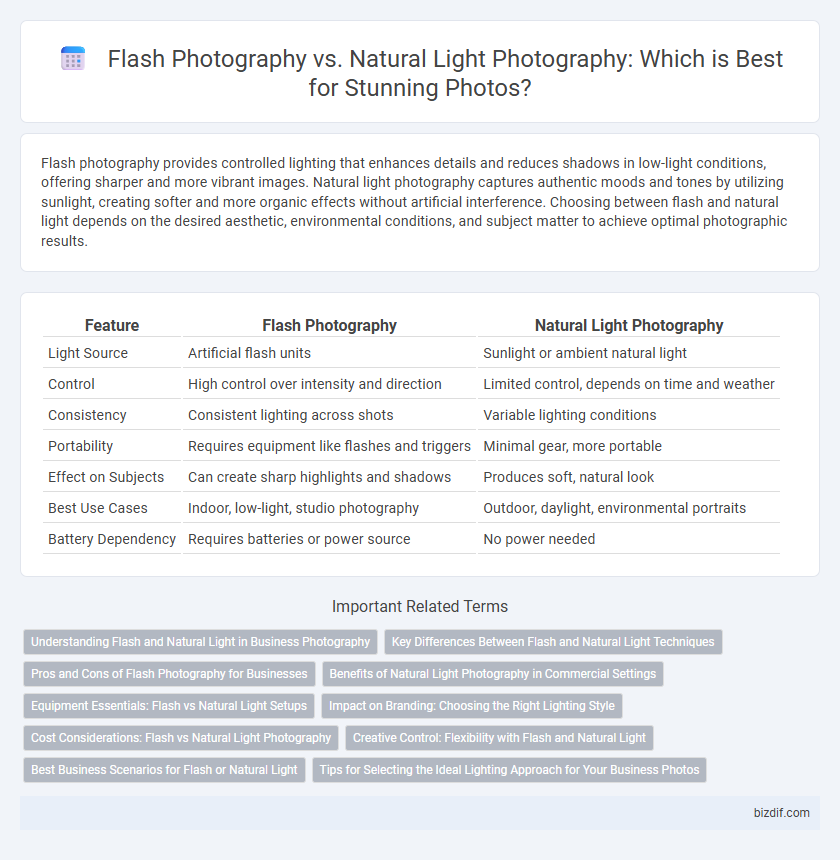Flash photography provides controlled lighting that enhances details and reduces shadows in low-light conditions, offering sharper and more vibrant images. Natural light photography captures authentic moods and tones by utilizing sunlight, creating softer and more organic effects without artificial interference. Choosing between flash and natural light depends on the desired aesthetic, environmental conditions, and subject matter to achieve optimal photographic results.
Table of Comparison
| Feature | Flash Photography | Natural Light Photography |
|---|---|---|
| Light Source | Artificial flash units | Sunlight or ambient natural light |
| Control | High control over intensity and direction | Limited control, depends on time and weather |
| Consistency | Consistent lighting across shots | Variable lighting conditions |
| Portability | Requires equipment like flashes and triggers | Minimal gear, more portable |
| Effect on Subjects | Can create sharp highlights and shadows | Produces soft, natural look |
| Best Use Cases | Indoor, low-light, studio photography | Outdoor, daylight, environmental portraits |
| Battery Dependency | Requires batteries or power source | No power needed |
Understanding Flash and Natural Light in Business Photography
Flash photography in business settings offers precise control over lighting, enhancing image clarity and consistency across various environments. Natural light photography leverages ambient sunlight to create authentic and warm tones, which can convey a more approachable brand image. Balancing flash and natural light techniques optimizes portrait quality, product presentations, and corporate event coverage for professional marketing materials.
Key Differences Between Flash and Natural Light Techniques
Flash photography utilizes artificial light sources to control exposure, freeze motion, and highlight subjects regardless of ambient lighting conditions. Natural light photography relies on sunlight or existing light sources, creating softer, more organic shadows and tones that vary throughout the day. Key differences include the control over lighting direction and intensity in flash, contrasted with the dynamic and often unpredictable quality of natural light.
Pros and Cons of Flash Photography for Businesses
Flash photography offers businesses consistent lighting, enabling sharp, well-exposed images regardless of ambient conditions, which is crucial for product catalogs and promotional materials. However, flash can produce harsh shadows and glare that may detract from the natural appeal of subjects, potentially requiring additional equipment like diffusers or reflectors for softer effects. While it provides control and reliability, flash photography demands technical skill and can increase shoot time and costs compared to natural light photography.
Benefits of Natural Light Photography in Commercial Settings
Natural light photography in commercial settings enhances product authenticity by capturing true colors and textures, appealing to customers' visual preferences. It reduces the need for bulky lighting equipment, streamlining setup time and lowering production costs. Utilizing natural light also creates a more inviting and organic ambiance, which can improve brand perception and engage audiences effectively.
Equipment Essentials: Flash vs Natural Light Setups
Flash photography requires essential equipment such as external flash units, diffusers, reflectors, and triggers to control and manipulate artificial light effectively. Natural light photography relies primarily on reflectors, diffusers, and sometimes portable light modifiers to optimize sunlight or ambient light conditions without the need for complex gear. Mastery of these setups ensures photographers can achieve desired lighting effects, enhancing image quality in diverse shooting environments.
Impact on Branding: Choosing the Right Lighting Style
Flash photography delivers consistent, high-quality images that enhance brand professionalism and control over visual aesthetics. Natural light photography offers authenticity and warmth, creating relatable and approachable brand imagery. Selecting the right lighting style directly influences brand identity, audience perception, and marketing effectiveness in visual storytelling.
Cost Considerations: Flash vs Natural Light Photography
Flash photography often requires an initial investment in equipment such as strobes, triggers, and modifiers, which can range from $200 to over $1,000 depending on the quality and brand. Natural light photography, by contrast, minimizes upfront costs as it relies on ambient light sources, though it may demand more time scheduling shoots during optimal lighting conditions. Considering ongoing expenses, flash photography may incur costs for batteries and maintenance, whereas natural light photography is virtually cost-free beyond standard camera gear.
Creative Control: Flexibility with Flash and Natural Light
Flash photography offers unparalleled creative control by allowing precise manipulation of light intensity, direction, and color temperature, essential for capturing dynamic portraits and fast-moving subjects. Natural light photography relies on ambient conditions, encouraging photographers to adapt and harness the quality of sunlight at different times of day for softer, more organic effects. Combining both techniques enhances versatility, enabling photographers to blend controlled artificial lighting with the natural atmosphere to achieve distinctive visual moods.
Best Business Scenarios for Flash or Natural Light
Flash photography excels in controlled environments such as studio shoots, product photography, and indoor events where consistent lighting is crucial for professional-quality images. Natural light photography thrives in outdoor settings, lifestyle shoots, and wedding photography, leveraging soft, ambient light to create organic and authentic visuals. Choosing between flash and natural light depends on the desired aesthetic, location constraints, and the need for lighting reliability in commercial projects.
Tips for Selecting the Ideal Lighting Approach for Your Business Photos
Choosing the ideal lighting for business photos depends on the desired mood and context; flash photography offers controlled, consistent light ideal for indoor settings and product shots, while natural light enhances authenticity and warmth in portraits and outdoor scenes. Consider the color temperature and intensity to ensure skin tones and brand colors are accurately represented, adjusting flash settings or shooting during golden hours for natural light. Testing both methods and analyzing how each complements your brand identity helps optimize visual impact and professionalism in your business images.
Flash Photography vs Natural Light Photography Infographic

 bizdif.com
bizdif.com